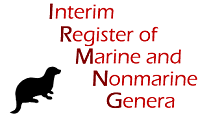
| Intro | | Search taxa | | Taxon tree | | Search literature | | Taxon match | | Homonyms | | Statistics | | Webservice | | Manual | | FAQ | | LifeWatch | | Download | | Log in |
IRMNG taxon detailsSpirodesmos André, 1920 †
marine,
fossil only
N. Jahrb. Min. Geol. Pal., 1920 (1), Heft 2
page(s): 85 [details]
Taxonomic remark Ichnogenus (fossil coprolite). From Knaust, 2020: Potential producer(s). The peculiar shape and appearance of the...
Taxonomic remark Ichnogenus (fossil coprolite). From Knaust, 2020: Potential producer(s). The peculiar shape and appearance of the Spirodesmos aggregates on the bedding surface has challenged its interpretation. While early workers recognized similarities with gastropod spawn (Andree 1920; Huckriede 1952), their nature as faecal strings became obvious on comparison with similar spiral-shaped strings of enteropneusts photographed in the modern deep sea (Horn 1989; Seilacher 2007). [details]
IRMNG (2021). Spirodesmos André, 1920 †. Accessed at: https://irmng.org/aphia.php?p=taxdetails&id=1130327 on 2025-05-18
Date action by
original description
N. Jahrb. Min. Geol. Pal., 1920 (1), Heft 2
page(s): 85 [details] basis of record Neave, S. A. and successors. (1939-2004). Nomenclator Zoologicus, vols. 1-10 online. [developed by uBio, hosted online at MBLWHOI Library]. Previously at http://ubio.org/NomenclatorZoologicus/ (URL no longer current). , available online at https://insecta.bio.spbu.ru/z/nomenclator_zoologicus_PDF.htm [details] verified source for family Knaust, D. (2020). Invertebrate coprolites and cololites revised. <em>Papers in Palaeontology.</em> 2020: 1-39., available online at https://doi.org/10.1002/spp2.1297 [details] name verified source Neave, S. A. and successors. (1939-2004). Nomenclator Zoologicus, vols. 1-10 online. [developed by uBio, hosted online at MBLWHOI Library]. Previously at http://ubio.org/NomenclatorZoologicus/ (URL no longer current). , available online at https://insecta.bio.spbu.ru/z/nomenclator_zoologicus_PDF.htm [details] current name source Knaust, D. (2020). Invertebrate coprolites and cololites revised. <em>Papers in Palaeontology.</em> 2020: 1-39., available online at https://doi.org/10.1002/spp2.1297 [details] extant flag source Knaust, D. (2020). Invertebrate coprolites and cololites revised. <em>Papers in Palaeontology.</em> 2020: 1-39., available online at https://doi.org/10.1002/spp2.1297 [details] habitat flag source Knaust, D. (2020). Invertebrate coprolites and cololites revised. <em>Papers in Palaeontology.</em> 2020: 1-39., available online at https://doi.org/10.1002/spp2.1297 [details] Unreviewed
Descriptive info From Knaust, 2020: Stratigraphic distribution. Upper Cambrian? (Aceñolaza 2005), Lower Carboniferous (Horn 1989). [details]Taxonomic remark Ichnogenus (fossil coprolite). From Knaust, 2020: Potential producer(s). The peculiar shape and appearance of the Spirodesmos aggregates on the bedding surface has challenged its interpretation. While early workers recognized similarities with gastropod spawn (Andree 1920; Huckriede 1952), their nature as faecal strings became obvious on comparison with similar spiral-shaped strings of enteropneusts photographed in the modern deep sea (Horn 1989; Seilacher 2007). [details] |